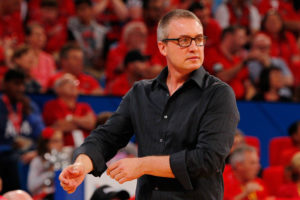A key element of coaching is to provide appropriately timed and delivered interventions to assist players with the learning and development journey.
With the speed of the game increasing all the time, succinct, efficient and thoughtful interventions in training and games are key to provide an effective learning environment for young players.
So, what are interventions in the coaching context? In essence an intervention is a statement, question, prompt or action that stimulates a change in behaviour by the athlete.
An effective intervention by the coach paints a picture with words to assist with the learning. The coaching greats across all sports have an innate ability to take a lot of information and deliver it in a short phrase or series of “action” words.
Efficiency and clarity of message are key in developing young athletes and effective use of interventions in the practice and game setting is an area all coaches should be constantly looking to develop.
In practice –
Most coaches embrace the concept of “coaching on the run” in the practice setting. This means not stopping drills or scrimmages constantly to correct or add detail and ensuring the focus is on the “doing”.
We know experiential learning (learning by doing) is key to modern coaching. But how do we ensure there is learning, correction and detail when coaching on the run?

Respected collegiate coach Mike Dunlap is credited for bringing the coaching method of praise, prompt & leave to Australian coaching.
- PRAISE– “good jump-stop on the elbow catch”
- PROMPT – “make sure you pivot to create the pass to the cutter”
- LEAVE– now move on and coach someone or something else
This succinct method allows for constant dialogue and teaching and also ensures coaches don’t get caught up with “over coaching”. While repetition is key to coaching, “repeating” is not in terms of words and cues.
One challenge for coaches is to limit the amount of repeating of instructions or information in the practice setting. There is a tendency for coaches to repeat instruction or paraphrase and present again, searching for that “lightbulb” where a player acknowledges “Oh, OK I get it now.”
There is a perception among many players that “coaches coach too much” and this is often linked to the repeating of even the most simple instructions.
The “leave” in this method allows the coach and athlete to move on quickly and adds to the efficiency of the practice.
Use of questioning is a valuable intervention strategy. Chicago NBA G-League mentor and former Emus coach Damian Cotter constantly asks players “what did you see there?” This allows players to unpack what is happening on the floor and is an example of guided learning.

The question inherently prompts thought and intrigue, rather than creates almost a “rote” learning environment. The quality of your practice can often be defined by the quality of the questions you and your coaches ask.
In the practice setting, ensuring assistant coaches are across the philosophy around interventions is important. The head coach needs to set the tone with this and there needs to be level of consistency across the staff.
In games –
Interventions are a little more challenging in the game setting. There are key times when a coach can impact interventions –
- Time-outs
- Quarter breaks
- Substitutions
- Dead ball situations
Structuring time-outs is so important to efficiency of impact. With a minute to communicate, make change, strategise and lead, this intervention needs to be planned and all stage need to be on the same page.
While it can be valuable to get input from assistant coaches prior to entering the huddle, too often you say coaches meet for 30 seconds prior and the coach then has less than 30 seconds to get the message across.
Similar structures need to be adopted with quarter and half-time breaks. These are obviously key times for coaches to intervene, but the balance has to be made between –
- Rest for the players on-floor
- Hydration
- Inter-player communication
- Review of what is happening
- Action plan – “this what we are going to do”
Substitutions are another key intervention, be it to change tempo of the game, provide rest, manage fouls or to strategically impact the game. Substituting and line-ups are such a crucial part of in-game coaching, yet often these aspects are not planned or discussed enough.
The dead-ball situation is a valuable opportunity for coach intervention. Coaches often espouse the value of the on-court group “huddling” in these breaks in play and that player driven communication is important. Every dead-ball situation is not the same, free throws are longer opportunities for communication than a violation for example.
These breaks can also be used to call a specific player over for brief instruction from the coach (often the point guard) or even just to communicate to athletes through signals or body language.
Like all coaching communication, striking a balance for these interventions is imperative. The point guard will soon tire of being called to the coach for instruction every time there is a whistle.
In both the practice and game environment, your positioning as a coach will impact the efficiency of your interventions. In practice, coaches need to be acutely aware of where they stand and position themselves. Are you close enough to impact and communicate in an efficient manner? Are you indeed a distraction?
In games, does your movement (or lack of) on the sideline impact what is happening on the floor? The subtleties of your body language and positioning can be interventions in themselves.
As with all aspects of developing and improving your coaching, taking time to consider how you effectively manage interventions is time well spent.




Leave a Reply